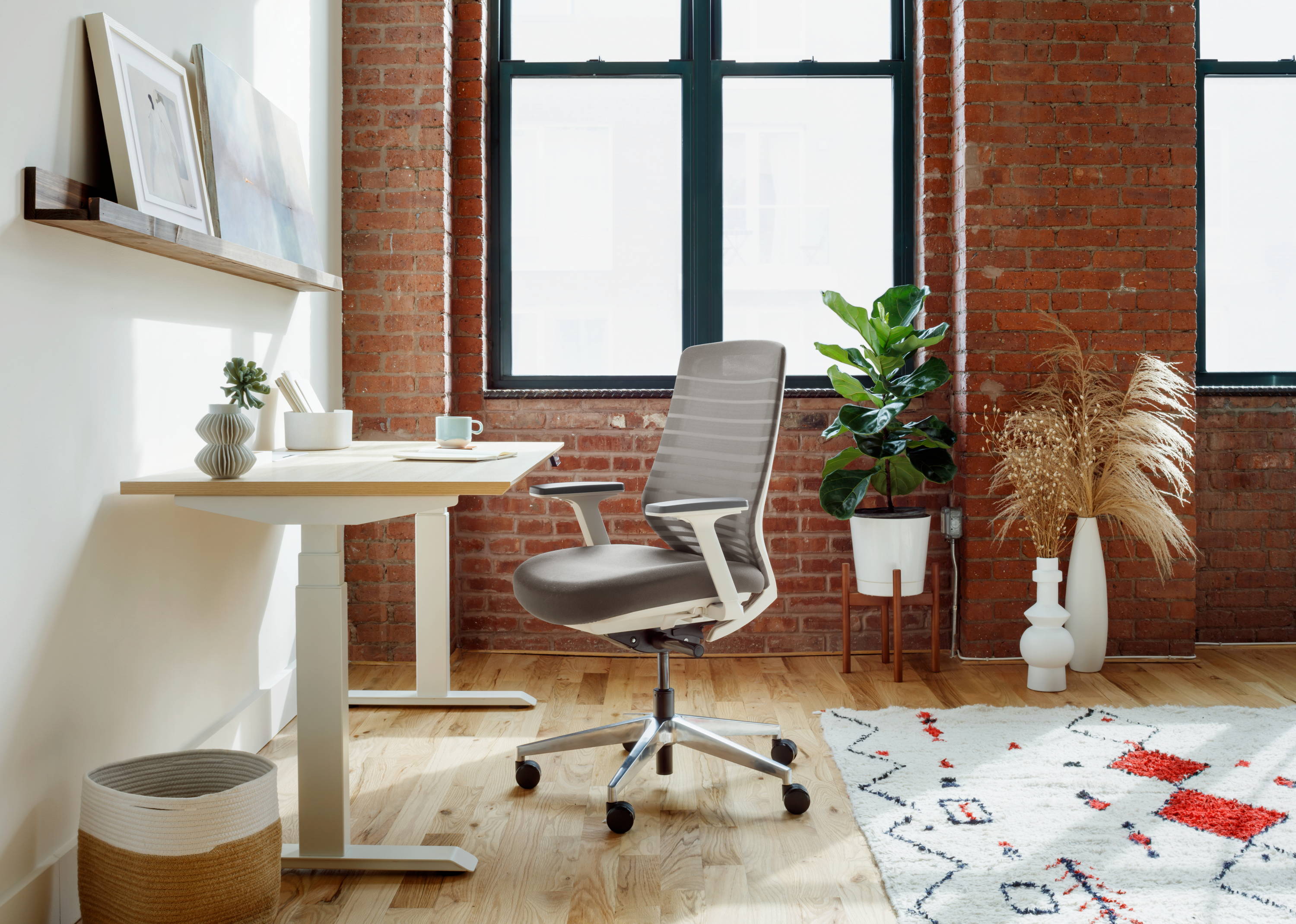Your home office should be an oasis of productivity and comfort. No matter the space, shared area, or restrictions, these three tips will help you set up a home office that helps you work even smarter.
Tired of working in an office that doesn’t make you work smarter? New to working from home? Jumping from dining chair to couch to armchair? It’s time to upgrade your home office setup.
Most of us spent our days in the typical office. Our home offices were relegated to the back of our minds, a spot where we occasionally completed bills, read a book, or caught up on last minute work. They weren’t quite set up as their own complete space, but rather as an afterthought. That was fine when only 3% of the US workforce telecommuted, or worked from home.
Think about your home. When you designed its setup, you probably thought about the style, look, feel, and function of the furniture. You chose your bed to represent your personality while helping you sleep better. Your dining table and chair setup looks great and fits the size of your family. The living room is a stylish meeting room centered around your typical family gathering, whether that is the occasional special occasion, watching sports games, playing the piano, or enacting charades and completing board games.
But did you do that for the home office? Is your desk and chair setup an ergonomic powerhouse? Do you have all the space you need to actually get work done? Are all your papers and files safely stowed away? Probably not.
Today, about 42% of workers in the US work from home offices (or spaces). We’re starting to feel the limitations of our home office setups. Back, neck, and shoulder pain bother us on a daily basis. We just don’t feel motivated when we sit down to work.
Your home office setup could dramatically increase your productivity. From the orientation of your furniture, to having proper lighting, to paint colors and decor, your perfect home office is not so far away. We’ll go through the 3 steps of creating the best office setup, no matter the type of space you have.
1. Choosing Your Space
Whether you are working at a cramped dining table, in your own spacious room, or are choosing your space, we have the tips to make it the best setup it can be.
2. Layout! Layout! Layout!
Who knew the placement of your computer, windows, and furniture mattered so much? They really do.
3. It's All in the Little Details
Personalizing your office with these pieces won’t just make it prettier; they will make you work harder.
Choosing Your Space
These first tips are essential for any home office setup. Then, we’ll dive into how you can make a shared space even better.
Look Down
… at the floors. The best office chairs have wheels, so they need to roll. Hardwood or tile floors are the best for moving around without fear. Carpet can wear away, have excess friction that makes moving difficult, and will develop unsightly track marks.
If you’re stuck with carpet, don’t worry. Invest in a chair pad! These handy sheets of vinyl, plastic, wood, or rug will help your chair roll smoothly without damaging your floors. Add your personal sense of style with clear, personalized, or wood designs. Expect to pay upwards of $30, depending on the material. You might just be limited to that rectangle strip of space, hence why hard floors are always optimal for the home office.
Make Room for Movement
If this is an option, choose a space that has enough room to move. You might think that a small crawl space or closet-sized room might be enough. It’s not. If your home office is going to be used often, you’ll need to move. Walking around, changing positions, and stretching throughout the work day will stimulate your mind and alleviate back pain.
Even better, have a space to exercise. If you can fit five minute stretches of yoga, sit ups, or jumping jacks in your home office setup, you’ll find improvements in:
- Concentration,
- Memory,
- Learning,
- Mental stamina,
- Creativity, and
- Stress levels
You don’t have to go to the gym to get these benefits. Save space for exercise, and you’ll find your work boosted by greater mental capacity and mood, which translates into greater performance and productivity.
If you don’t have a lot of space, expand your office by turning a closet into a desk nook. Just remove the pole, any shelving, and you’re good to go!
See the Sun
Lightbulbs hold nothing to natural light. With a well placed window, your home office setup will be bathed in light. That means better sleep because your circadian rhythm will follow cues from the sunlight outside your room. Studies have also shown that controlled daylight reduces symptoms of eyestrain, headaches, and blurred vision by 84%. It also correlates with a 10% drop in drowsiness and an increase in productivity.
There’s also a number of health benefits, including getting a healthy dose of vitamin D, preventing seasonal depression, and eliminating the stress risks of fluorescent lighting. (Fluorescent lighting can increase stress levels for certain individuals.) Lighting makes us healthier, happier, and more productive. What can’t it do?
If your office setup doesn’t have a lot of windows, here’s how to see more of the sun:
Get some mirrors! The more mirrors, the better. Place them in the path of the sun rays that enter your room. Add another where the mirror reflects the light. Another plus? It’ll make your office feel even larger.
Get rid of curtains. You probably won’t be in your office late at night, so get rid of those light-blockers.
Windows also provide a healthy sense of time and outside stimuli. Look up from your desk in between tasks, and take a moment to pause and refresh.
Paint it up
Those office walls need a redo. From stimulating your creative juices to enhancing your alertness, the paint color in your home office setup can improve the way you work.
Blue improves mental power and concentration. It’s a great choice if you need to stay focused for long periods of time.
Red stimulates your body’s physiological responses and increases energy levels. If you need to move and be physically alert, use this color. If you’re prone to stress and need calming stimuli, avoid at all costs.
Yellow is the color of happiness! It’s energizing and mood-boosting. Get those creative juices flowing with this color. Yellow hues can also improve your perception of the work you produce.
Green is a calming color for your mind and eyes. If you want a color that continues to soothe you throughout the day, choose this. We recommend this as our favorite office color!
Not ready to repaint your walls? Add splashes of your chosen color with pictures on the wall, thoughtful accessories, colorful cushions, and a new desktop background.
So you have a whole room?
Lucky you! Follow the steps above, and you’ll be on your way to a balanced home office setup.
Pro tip: make sure to have a stow-away drawer for phones and other technology you don’t need for work. Out of sight, out of mind.
Don't have your own space?
You can still create a great home office setup. Read on!
If you have a desk, keep it separate. Desk = office. Don’t use it for leisure or as place to store random clutter. Remind your home-mates that your desk is yours. It’s not to be disturbed, just like they wouldn’t randomly drop by your office to store a book or complete an assignment.
If you don’t have a desk, choose a table that is not too tall. You can add desktop and keyboard risers, but you can never shorten it! Have a discussion with your roommates, family, or children. This part of the table is your office. That means that no matter the time of day, it is to stay separate and unused. Delineating your work space from home space will help you turn your work brain “on” and “off.”
If you have to use a multipurpose space, ritualize the act of clearing your office and setting it up. Set up your office in the morning to get into performance-mode. Clear your office when you’re done for the day to start relaxing. (Stay tuned for helpful organizational accessories!) Remember that closet tip? You can also make that your desk cubby space in a shared room. If you have stairs, set up a desk and chair in that little bit of extra landing space.
Pro tip: Choose the least frequented area of your home, while following our tips above. If traffic is unavoidable, it might be worth it to invest in a pair of noise-cancelling earbuds.
Layout! Layout! Layout!
Now that you’ve chosen your space, it’s time to position your furniture for the best home office setup ever.
Windows
What can you do about windows? Not much, they don’t move. But your furniture does!
Make sure not to have a window behind you. Bright light might reduce your monitor visibility or create glare. Avoid windows that direct light towards your screen from the sides too. That might mean placing your desk in the middle of the room or adding a thin shade to a troublesome window during especially sunny hours.
Lighting
Your ambient lighting should always match the brightness of your screens. Otherwise, you’re in for eye strain as your eyes continue to adjust when looking from screen to room to screen. Don’t put lamps next to or behind your screens either. The same logic follows. (And it can cause glare.) Your eyes will thank you!
The Power of Ergonomics
You’ve placed your furniture in the room, but you’re not done yet. It’s time to adjust every desk, chair, and monitor to fit you.
Follow the right-angle rule when adjusting your chair for less back pain and proper body alignment. Your chair should be adjusted height-, depth-, and armrest-wise to make sure your legs, back, and arms are in the right places.
- Raise your seat height with feet firmly planted, until you find your thighs perfectly perpendicular to your calves. Keep your thighs parallel to the ground too! Your knee bend should be comfortably supported by the chair without your feet leaving the ground.
- Adjust the depth of your chair so that you can sit along the back, without messing up your leg alignment. Keep your posture stick-straight! Allowing for the natural curve of your lower spine, your lower back should be in line with your upper back. It might feel fine to slouch in a comfy arm chair or lean your lower back further in at the moment, but it’ll materialize in back pain later on.
- If you have armrests, they shouldn’t hold the weight of your upper body. Instead, they should serve as a place for your arms to naturally rest while your shoulders stay calm and dropped. Your upper arm should be perpendicular to your lower arm, and your lower arm should be parallel to the ground or desk when typing or writing.
If you don’t have an adjustable chair, invest in an office chair that can be fine-tuned to your body. Not ready to purchase one? Add a pillow to the back of your chair so that your seat depth allows for prime posture.
Just like your office chair, your office desk needs to be the right height for you. If it’s too tall, you won’t be able to type or write comfortably. Make sure that your desk and chair align so that you can write and type with your lower arms perfectly parallel to the ground. Standing desks provide ample flexibility for optimal ergonomics, among other productivity benefits. Add an ergonomic keyboard for proper wrist alignment and comfort.
Your computer screens and monitors need to be up high! Avoid neck and back pain with this rule: your eyes should rest under the top 20-25% of the screen. That means a ¼ of the screen should be above your line of sight, with the rest under it. Purchase monitor risers or invest in an adjustable monitor arm to achieve that perfect height.
Additional seating
If you have clients, coworkers, or a family member that likes to stop by, purchase a comfortable guest chair or two. They’ll serve as attractive additions and a place to work when you don’t need a desk.
It’s All in the Little Details
You’ve set up all the essentials. Now it’s time to fine-tune your home office setup.
Tick. Tock.
Add a timepiece to your space. Whether that’s an analog clock on the wall or a digital display on your desk, keep track of general time. Don’t stress the small minutes. Use your clock to structure your start and end to the day. Only 17% of people can accurately track the passage of time.
Learn to pause and relax at consistent times throughout the day. Regular breaks actually help with concentration and maintaining performance. Working without breaks isn’t enjoyable and will produce inferior results. So just don’t do it! To maximize productivity, work in 90-minute periods. Studies have landed on that hour and a half as the prime amount of time to work straight.
Keep it all together
Do you have stacks of papers and folders all over your office setup? It’s time to get organized. Stow away important files in lockable filing cabinets. Invest in an attractive credenza that functions as a home decor piece that stores office files, backpacks, and books alike. Studies have found that workers waste about 4.5 hours of productivity, every single week looking for documents.
Wires begone!
All that technology can translate into tangled wires and unattractive extension cords. Purchase wire organizers and desks with handy cable ports to avoid all that mess, and the headaches that come with it.
If you don’t need it, toss it
It’s easy for your desk to gather piles of pens, random papers, and little mementos. Make sure to clear your office of anything that distracts or detracts from your work. Having a clear desk will reduce stress and help you focus on one task at a time.
Add life to your space
You don’t need to be the sole living being in your office setup. Add plants! Studies have shown that plants increase workplace satisfaction, levels of concentration, and perceived air quality. Those little green figures can increase productivity by about 15%. Certain species actually improve air quality, like spider plants, snake plants, or aloe vera. Another plus? Better indoor air quality can double your cognitive functions.
Personalize
Decorate your home office setup with images, pieces, and furniture that inspire and motivate you. Bright artwork, calming mantras, or family photos can help you push through long days.
Stimulate your other senses with smells and sounds. Use diffusers, candles, or dried herbs. Scents like eucalyptus, mint, and citrus stimulate awareness and alertness. Others like lavender, cinnamon, and bergamot are calming and comforting.
Play some tunes with earphones or speakers. Listen to your favorite songs to get energized. If you find yourself getting too absorbed in the lyrics, switch to lyric-free music. Classical music and jazz can improve your mood and memory without becoming distracting.
If you suffer from eye strain or fatigue, check out blue-light glasses at companies like Felix Gray, to alleviate these symptoms common to long hours looking at digital screens.
Make your home office setup your own. It’s the little things that will fine-tune your office into a productivity and performance powerhouse.
It’s not hard to set up an office. But it’s also not just about choosing your desk and chair, or computer and monitor screens. Follow these tips and your home office won’t just be a sterile setup, it’ll be a place that you perform your absolute best.
If you’re ready to get furniture pieces made for the office, start shopping here.
On new furniture, exclusive sales and more.







